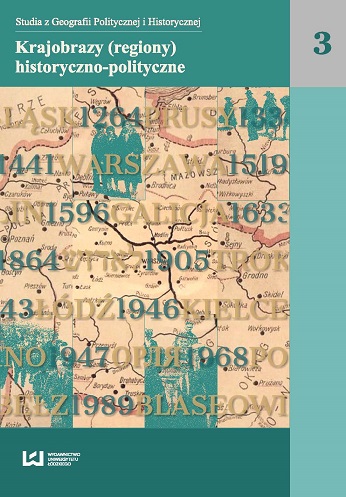Rebirth of the Orthodox Church in the Lemko Region after 1956 as a part of the multicultural region
DOI:
https://doi.org/10.18778/2300-0562.03.14Keywords:
Lemkos, Lemko religious minorities, OrthodoxyAbstract
As a result of the post-war resettlement (1944–1946) to the areas of the Ukrainian SSR , then to the so-called recovered territories, as part of the „Vistula Action” (1947), the area of Orthodox Lemkos’ religious life ceased to exist. Most historic temples with their equipment were destroyed. The Orthodox property was plundered. The process of restoration of the Orthodox parish network began after 1956. Its result was the establishment of Rzeszów Deanery already in 1959. The revival of the parish structures encountered numerous difficulties. Among the most important should be mentioned unfavorable position of local religious authorities, poor conditions of the temples, the lack of clergy. However, by the end of the 60s it had been possible to create a network of parish temples, which in general satisfied the religious needs of the faithful. The key moment for the development and stabilization of the religious life was the erection of Przemysl – Nowy Sacz Diocese in 1983. Following the democratic changes taking place in Poland after 1989, Orthodox Church began a new period in its operations. In addition to the integration, because of the emerging opportunities, in a wider range it could fulfill its culture-creating role and become an important element of the multicultural region.References
Barna A., 2008, Chmury i słońce nad Łemkowyną, Oficyna Wydawnicza Atut–Wrocławskie Wydawnictwo Oświatowe, Wrocław.
Google Scholar
Bendza M., 1982, Prawosławna diecezja przemyska w latach 1596–1681, Warszawa.
Google Scholar
Bołtryk M., 1995, Duma Łemków, [w:] Radziukiewicz A., Bołtryk M. (red.), Precz z mnichami, Białystok.
Google Scholar
Dubec R., 2005, Recepcja św. Maksyma Gorlickiego w Polsce i na świecie, „Almanach Diecezjalny”, t. 1, s. 97–102.
Google Scholar
Dubec R., 2006, Proces odradzania się Kościoła prawosławnego na Łemkowszczyźnie w okresie międzywojennym (1926–1939), „Almanach Diecezjalny”, t. 2, s. 49–70.
Google Scholar
Dubec R., 2007, Prawosławie wśród Rusinów Karpackich na przełomie XIX i XX wieku, „Almanach Diecezjalny”, t. 3, s. 9–17.
Google Scholar
Dubec R., Felenczak J., 1999, Szematyzm. Katalog świątyń i duchowieństwa prawo sławnej diecezji przemysko-nowosądeckiej, Gorlice.
Google Scholar
Dudra S., 2004, Kościół prawosławny na ziemiach zachodnich i północnych Polski po II wojnie światowej, Zielona Góra.
Google Scholar
Dudra S., 2009, Prawosławna parafia w Polanach. Z dziejów konfliktu, „Cerkiewny Wiestnik”, 1, s. 34–44.
Google Scholar
Dudra S., 2012, Erygowanie parafii prawosławnej w Rozdzielu jako element polityki wyznaniowej w powojennej Polsce, „Rocznik Ruskiej Bursy”, s. 73–82.
Google Scholar
Gerent P., 2005, Zarys dziejów prawosławnej diecezji przemyskiej, „Almanach Diecezjalny”, t. 1, s. 23–49.
Google Scholar
Gerent P., 2006, Proces powstawania parafii prawosławnych na Podkarpaciu po 1956 roku, „Antyfon”, 1, s. 11–13.
Google Scholar
Gerent P., 2007, Prawosławie na Dolnym Śląsku w latach 1945–1989, Toruń.
Google Scholar
Inwentaryzacja łemkowskich cmentarzy w nieistniejących wsiach na terenie gminy Sękowa, cz. 1: Banica, Długie, Lipna (stan na 31.10.2002), 2003, Dubec R. (red.), Gorlice.
Google Scholar
Krochmal A., 1992, Stosunki między grekokatolikami i prawosławnymi na Łemkowszczyźnie w latach 1926–1936, [w:] Czajkowski J. (red.), Łemkowie w historii i kulturze Karpat, cz. 1, Rzeszów, s. 285–299.
Google Scholar
Kuprianowicz G., 2003, Akcja „Wisła” a Kościół prawosławny, [w:] Pisuliński J. (red.), Akcja „Wisła”, Warszawa, s. 153–173.
Google Scholar
Moklak J., 1997, Łemkowszczyzna w Drugiej Rzeczypospolitej. Zagadnienia polityczne i wyznaniowe, Kraków.
Google Scholar
Radziukiewicz A., 2003, Weź krzyż i idź za mną, „Przegląd Prawosławny”, 3: http://www.przegladprawoslawny.pl/articles.php?id_n=329&id=8
Google Scholar
Reinfuss R., 1990, Śladami Łemków, Warszawa.
Google Scholar
Reinfuss R., 1998, Łemkowie jako grupa etnograficzna, Sanok.
Google Scholar
Schematyzm. Katalog świątyń i duchowieństwa prawosławnej diecezji przemysko-nowosądeckiej, 1999, opr. R. Dubec, J. Felenczak, Gorlice.
Google Scholar
Sobolewski J.L., 1983, Spór o cerkiew, „Życie Literackie”, 17, s. 8–10.
Google Scholar
Urban K., 1996, Kościół prawosławny w Polsce 1945–1970, Kraków.
Google Scholar
Urban K., 1998, Z dziejów Kościoła prawosławnego na Dolnym Śląsku 1946–1956, Białystok.
Google Scholar
Żywot świętego Maksyma Gorlickiego (Sandowicza), „Almanach Diecezjalny”, 2005, t. 1, s. 79–96.
Google Scholar
Downloads
Published
How to Cite
Issue
Section
License

This work is licensed under a Creative Commons Attribution-NonCommercial-NoDerivatives 4.0 International License.








